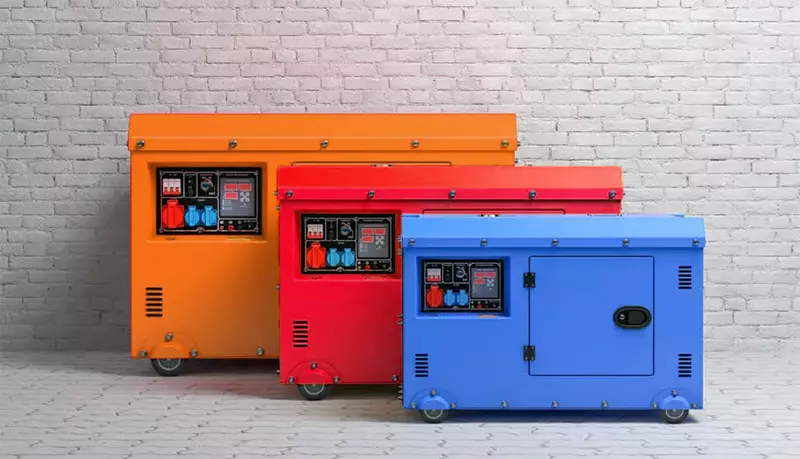04Apr 2024
table of contents

Within the constantly advancing domain of power systems, it's essential to grasp the fundamental principles of electricity. Two terms that frequently get oversimplified or omitted, yet are highly significant, are kW and kVA. Although these units may seem interchangeable, their differences are important in understanding your power needs.
In this article, BISON generator manufacturer will discuss in detail what kW is and what kVA stands for. We’ll take you through a thorough understanding of kW and kVA by discussing the differences between these two units of measurement in depth. Let’s improve your knowledge together!
Kilowatt is a unit of active power, often called active power or rated power. Essentially, active power represents the actual work done.
Think of a generator, this power rating essentially represents the actual power output the machine can deliver based on the engine's horsepower. Therefore, the kilowatt output value is crucial when choosing a generator that suits your requirements.
How to calculate kilowatts? The computation of a generator's power rating involves multiplying its horsepower rating by 0.746. To provide an illustration, if a generator is powered by a 400 hp engine, then the power generated would equate to 298.4 kilowatts.
kW and kVA are units that represent apparent power and are often mistaken for active power. But what exactly is kKA? Next let's explore kilovolt ampere.
KVA is also called apparent power, which is a combination of active power (we have already discussed it) and reactive power. Active power (measured in kilowatts) is responsible for productive work, such as powering machines, while reactive power is responsible for preparatory work. It establishes the magnetic field and stabilizes the voltage, allowing the real power to perform its task. Therefore, kVA (or apparent power) reflects the sum of the actual work and the necessary base work.
On the generator side, kVA corresponds to the capacity of the generator-side system. Essentially, it represents the total potential of the power system to handle electricity, even if not all of it is put into actual use. It is similar to the capacity of a power plant and represents the maximum amount of electricity it can efficiently handle and distribute.
Think of kVA as the diameter of a water pipe. Larger diameter pipes have the inherent ability to handle larger total water flows. This does not mean that all the water must be used for the job; rather, it means the potential or total capacity of the pipeline. Likewise, a higher kVA rating indicates a larger "pipe size" for current flow or greater ability to handle power, even if not all of it contributes to real power (actual work done).
Now that we’ve explored what kW and kVA each represent. In the following sections, we’ll address the key issue—the differentiating factors between kW and kVA—and explore why this difference is critical for efficient power utilization.

The main difference between KW and KVA is power factor.
Power factor is affected by the nature of the circuit involved. When dealing with direct current (DC) circuits, since current and voltage flow in the same phase, kW and kVA become the same. In other words, in a DC environment, there is no separation or delay between voltage and current, and there is no "reactive power" at play. This results in a power factor equal to 1, making kW equal to kVA.
However, the situation changes when we consider alternating current (AC) circuits. In these circuits, due to inductive and capacitive loads, the current often fluctuates and is out of phase with the voltage, resulting in real and reactive power. This is the difference between kW and kVA.
To measure this difference, we use a simple but effective formula:
Apparent Power (kVA) x Power Factor = Real Power (kW)
The power factor here represents the ratio of actual power (kW) to apparent power (kVA). For many applications, this fraction is typically around 0.8, summarizing the efficiency of the electrical system. Because of this factor, kVA values are usually higher than kW values and represent the total power available in the system versus the portion of power that is actually available.
After discussing the differences between kW and kVA, we now turn our focus to their practical applications. By understanding when to consider kW and when to consider kVA, we can not only make more informed decisions about our power needs, but we can also optimize resources and prevent waste.
Deciding on the size of a generator requires careful evaluation of capacity (kVA) (representing the total power the generator can handle) and actual power requirements (kW) (the amount of electricity required by the generator).
For general household applications, when you're calculate the power requirements of commonplace appliances, ranging from refrigerators to air conditioners or televisions, the key unit to consider is kW.
However, in industrial and commercial applications, the situation has changed, with greater power and complex electrical loads appearing. Many areas use these two units in different ways on a wider scale. For example, in the United States and some other countries that operate at 60 Hz, kW is primarily used when referring to generator sets. In contrast, many other countries around the world essentially rely on kVA as the primary designation for generating units. This difference is deeply rooted in the nature of the electrical loads used in these areas.

By understanding specific usage scenarios for kW and kVA, you can better assess your power needs, manage your resources effectively, and prevent under- or over-capacity situations. Although kilowatts and kVAs may seem like just units of measurement, they have considerable impact on our daily lives and power management decisions.
inquiry form here
BISON BLOG, All the latest news and views from Bison Machinery.